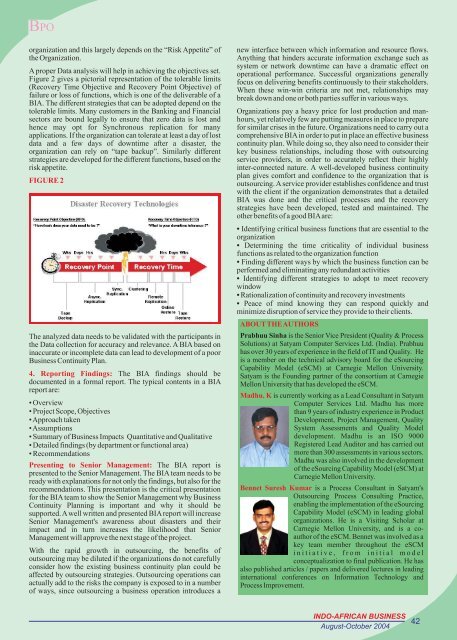BPObusiness functions as related to organization function.3. Determine required available time (Recovery TimeObjective) for functional departments.4. Determine the sequence of recovering critical functions in theevent of a disaster.A BIA provides• Financial impacts by business unit, location, <strong>and</strong> the overallorganization.• Operational impacts by business unit, location <strong>and</strong> the overallorganization.• Current state of preparedness.• Extra expenses necessary to continue operations after adisruption.• Technology requirements for recovery.• Special recovery resources.BIA results are used to decide• What are the critical business functions that are essential to thesurvival of the organization?• How quickly critical business functions have to be back inbefore the impacts are catastrophic.• What are the different strategies to adopt to meet the recoverywindow?• What resources are needed to resume operations at anacceptable level?• What elements must be pre-positioned in order to meet therecovery window?Phases of Business Impact Analysisorganization culture.Care should be taken when developing the questionnaires. Thequestionnaire should be basic <strong>and</strong> short; should have a logicalflow, <strong>and</strong> should be close-ended questions. Also, the topicalquestions should be grouped together <strong>and</strong> easier questionsshould build to complex questions within groups.For data collection by interview, develop interview guide, traininterviewers <strong>and</strong> have a proper schedule. While conductinginterviews, the interviewer needs to be consistent <strong>and</strong>conversational <strong>and</strong> stay focused <strong>and</strong> maintain control. Also, thedata provided by the interviewee needs to be validated. Theadvantage of data collection through interviews is that one canexplore ideas that might be missed with questionnaire approach.a. Business Impact: The purpose is to determine the potentialimpact to the organization in the event of an outage affecting adepartment. Information on what would be the business impacton the organization if this department could not function <strong>and</strong>meet its business obligations over a period of time 4 hours, 8hours, 24 hours, 3 days etc. The impact can be quantitative(financial) or qualitative (non-financial). Each organization willhave a different measure for the impact.b. Business Processes: What are the different businessprocesses performed by the department? For each process,provide its name <strong>and</strong> a brief description <strong>and</strong> rate its level ofimportance to the organization based upon the impact of itsTypically a BIA is composed of five phases.unavailability. For the critical business processes identified in1. Project Planning the department, get the details like average volume of business2. Data Collection transactions, processing time frames, workflow relationships3. Data Analysis <strong>and</strong> dependencies.4. Reporting Findings5. Presenting to Senior Management1. Project Planning: The initial step in a BIA is to define theobjectives <strong>and</strong> determine the scope of BIA. The preferredapproach is to have all business functions in the scope <strong>and</strong> not tohave preconceived assumptions on the criticality of businessfunctions until the analysis is completed. Having defined theobjectives <strong>and</strong> scope, the same should be presented to the SeniorManagement to obtain their commitment. Once these items areagreed upon, a project team should be formed. The project teamshould have employees with appropriate knowledge about thebusiness processes (Business Experts), Technology Experts,Financial experts, third party staff or a combination. Next adetailed project schedule needs to be developed. Theannouncement about the project needs to be made to theparticipants by the Senior Management. The announcementshould typically include a memo from Senior Managementstressing the importance of the project <strong>and</strong> the need for fullparticipation <strong>and</strong> co-operation. The Senior Managementcommitment can typically be demonstrated by having a policyfor Business Continuity.2. Data Collection: Data should be collected from variousorganizational units <strong>and</strong> from relevant business partners.Information systems can be complex, with a wide range ofcomponents, interfaces <strong>and</strong> processes. The BIA team shouldidentify all interdependencies among these items, <strong>and</strong> identifythe personnel from whom the information needs to be obtained.3. Data Analysis The data obtained in the previous phase needsto be clearly examined <strong>and</strong> analyzed by the BIA team to identifycritical information systems <strong>and</strong> processes, as well as potentialdisaster impacts. The analysis method to be used should be pre-defined <strong>and</strong> the criteria on which analysis will be done needs tobe determined. The criteria vary from organization toData collection is the most critical part of BIA. Data collectioncan be done using a structured set of questionnaires or havinginterviews with the concerned people or having a combinationof questionnaire <strong>and</strong> interviews. The best approach to datagathering depends on the circumstances of the project <strong>and</strong> theThough each organization's need of data is different, some ofthe aspects that can be considered during data collectionare:c. Recovery Strategies: Obtain the recommended businesscontinuity strategy for the department over the various timeframes.d. Resource required: Obtain the resources required by thedepartment if the business process needs to be conducted at abusiness recovery/alternate site. Also, get the vital records <strong>and</strong>critical files needed for recovery purposes <strong>and</strong> where the recordsare kept/stored.ChallengesThe primary difficulty that the BIA project team typically facesis in identifying the “Critical” business functions. Since theemployees feel intimidated if their functions are not identified as“Critical” business functions. To overcome this, the BIA projectteam may end up identifying all the functions as “Critical”,which does not serve the purpose. To avoid this situation, theBIA team can try to clearly define the objectives of the BIA <strong>and</strong>the associated deliverables <strong>and</strong> communicate the same to therelevant stakeholders. Then, the team can educate stakeholderson the context in which 'criticality' is being determined <strong>and</strong> seekstakeholder inputs to identify 'critical' business functions.Another difficulty arises in establishing appropriate measures toassess the impact of non-availability of a business function.Establishing consensus among stakeholders on the measures,especially for non-quantitative impacts can be an uphill task.INDO-AFRICAN BUSINESS 41August-October 2004
BPOorganization <strong>and</strong> this largely depends on the “Risk Appetite” of <strong>new</strong> interface between which information <strong>and</strong> resource flows.the Organization.Anything that hinders accurate information exchange such assystem or network downtime can have a dramatic effect onA proper Data analysis will help in achieving the objectives set.operational performance. Successful organizations generallyFigure 2 gives a pictorial representation of the tolerable limitsfocus on delivering benefits continuously to their stakeholders.(Recovery Time Objective <strong>and</strong> Recovery Point Objective) ofWhen these win-win criteria are not met, relationships mayfailure or loss of functions, which is one of the deliverable of abreak down <strong>and</strong> one or both parties suffer in various ways.BIA. The different strategies that can be adopted depend on thetolerable limits. Many customers in the Banking <strong>and</strong> Financial Organizations pay a heavy price for lost production <strong>and</strong> mansectorsare bound legally to ensure that zero data is lost <strong>and</strong> hours, yet relatively few are putting measures in place to preparehence may opt for Synchronous replication for many for similar crises in the future. Organizations need to carry out aapplications. If the organization can tolerate at least a day of lost comprehensive BIAin order to put in place an effective businessdata <strong>and</strong> a few days of downtime after a disaster, the continuity plan. While doing so, they also need to consider theirorganization can rely on “tape backup”. Similarly different key business relationships, including those with outsourcingstrategies are developed for the different functions, based on the service providers, in order to accurately reflect their highlyrisk appetite.FIGURE 2inter-connected nature. A well-developed business continuityplan gives comfort <strong>and</strong> confidence to the organization that isoutsourcing. A service provider establishes confidence <strong>and</strong> trustwith the client if the organization demonstrates that a detailedBIA was done <strong>and</strong> the critical processes <strong>and</strong> the recoverystrategies have been developed, tested <strong>and</strong> maintained. Theother benefits of a good BIA are:• Identifying critical business functions that are essential to theorganization• Determining the time criticality of individual businessfunctions as related to the organization function• Finding different ways by which the business function can beperformed <strong>and</strong> eliminating any redundant activities• Identifying different strategies to adopt to meet recoverywindow• Rationalization of continuity <strong>and</strong> recovery investments• Peace of mind knowing they can respond quickly <strong>and</strong>minimize disruption of service they provide to their clients.The analyzed data needs to be validated with the participants inthe Data collection for accuracy <strong>and</strong> relevance. A BIA based oninaccurate or incomplete data can lead to development of a poorBusiness Continuity Plan.4. Reporting Findings: The BIA findings should bedocumented in a formal report. The typical contents in a BIAreport are:• Overview• Project Scope, Objectives• Approach taken• Assumptions• Summary of Business Impacts Quantitative <strong>and</strong> Qualitative• Detailed findings (by department or functional area)• RecommendationsPresenting to Senior Management: The BIA report ispresented to the Senior Management. The BIA team needs to beready with explanations for not only the findings, but also for therecommendations. This presentation is the critical presentationfor the BIA team to show the Senior Management why BusinessContinuity Planning is important <strong>and</strong> why it should besupported.A well written <strong>and</strong> presented BIA report will increaseSenior Management's awareness about disasters <strong>and</strong> theirimpact <strong>and</strong> in turn increases the likelihood that SeniorManagement will approve the next stage of the project.With the rapid growth in outsourcing, the benefits ofoutsourcing may be diluted if the organizations do not carefullyconsider how the existing business continuity plan could beaffected by outsourcing strategies. Outsourcing operations canactually add to the risks the company is exposed to in a numberof ways, since outsourcing a business operation introduces aABOUT THE AUTHORSPrabhuu Sinha is the Senior Vice President (Quality & ProcessSolutions) at Satyam Computer Services Ltd. (<strong>India</strong>). Prabhuuhas over 30 years of experience in the field of IT <strong>and</strong> Quality. Heis a member on the technical advisory board for the eSourcingCapability Model (eSCM) at Carnegie Mellon University.Satyam is the Founding partner of the consortium at CarnegieMellon University that has developed the eSCM.Madhu. K is currently working as a Lead Consultant in SatyamComputer Services Ltd. Madhu has morethan 9 years of industry experience in ProductDevelopment, Project Management, QualitySystem Assessments <strong>and</strong> Quality Modeldevelopment. Madhu is an ISO 9000Registered Lead Auditor <strong>and</strong> has carried outmore than 300 assessments in various sectors.Madhu was also involved in the developmentof the eSourcing Capability Model (eSCM) atCarnegie Mellon University.Bennet Suresh Kumar is a Process Consultant in Satyam'sOutsourcing Process Consulting Practice,enabling the implementation of the eSourcingCapability Model (eSCM) in leading globalorganizations. He is a Visiting Scholar atCarnegie Mellon University, <strong>and</strong> is a coauthorof the eSCM. Bennet was involved as akey team member throughout the eSCMinitiative, from initial modelconceptualization to final publication. He hasalso published articles / papers <strong>and</strong> delivered lectures in leadinginternational conferences on Information Technology <strong>and</strong>Process Improvement.INDO-AFRICAN BUSINESS 42August-October 2004

















